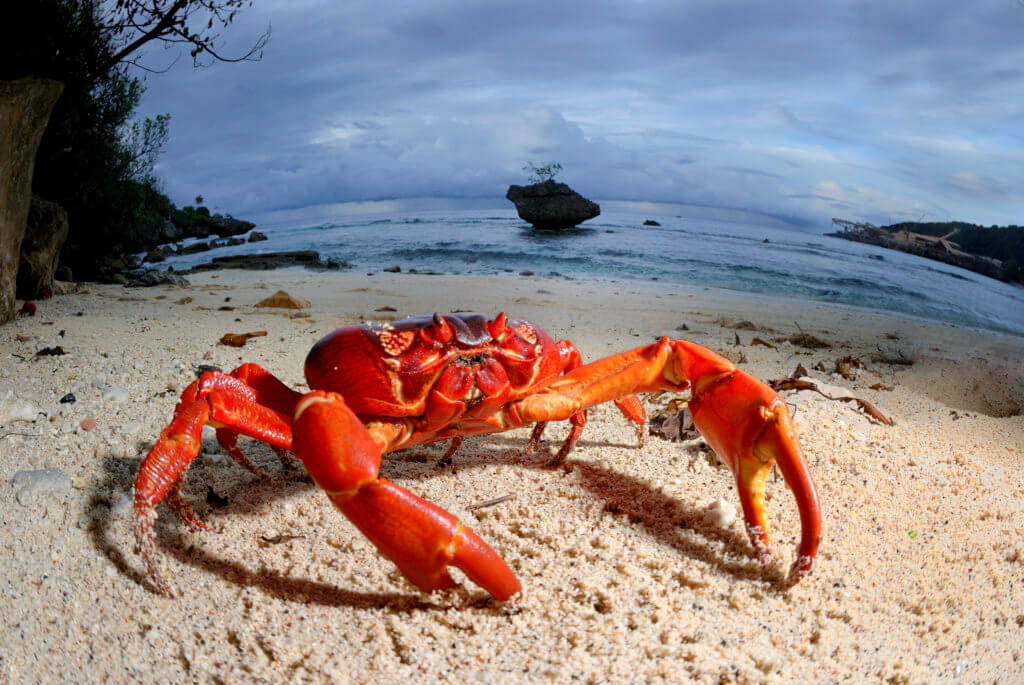
Australia’s Christmas Island red crabs, found only on Christmas Island, rely on the surrounding oceans to breed.
More information
What are the Christmas and Cocos (Keeling) Islands?
The Christmas and Cocos Islands lie thousands of kilometres off the north-west coast of the Australian mainland.
Christmas Island is famous for its annual red crab migration. It’s also a haven for thriving rainforests, deserted beaches and a fringing reef home to rare seabirds and other marine life.
Nearby, the Cocos (Keeling) Islands are Australia’s secret island paradise! Sitting at the top of an ancient sea mountain, its beautiful blue lagoon hosts tropical fish, corals, turtles, manta rays and dolphins.
But, over the years, the presence of illegal fishing began to grow in the oceans around these islands.
The oceans surrounding Christmas and the Cocos (Keeling) Islands are also under increasing pressure from climate change impacts.
Show/Hide Submission Text
Dear Director of National Parks,
[YOUR OPTIONAL PERSONAL MESSAGE WILL APPEAR HERE]
I strongly support the draft management plans for the globally significant Christmas Island and Cocos (Keeling) Islands Marine Parks in Australia’s Indian Ocean Territories.
The sanctuary zoning of Australia’s Indian Ocean Territory (IOT) marine parks makes them some of the world’s biggest and best protected marine areas in the world. This is a huge achievement for Australia.
I support the current zoning plans – co-designed with the island communities – which protect 739,000km2 of Australia’s waters around the islands, while supporting sustainable fishing in nearshore waters by the local community.
The size and high level of this sanctuary protection will help safeguard one of the most unique and threatened marine bioregions in Australia, and significantly contribute towards Australia’s commitment to 30% protection of our marine estate by 2030.
The marine parks cover one of the most under-protected marine environments globally. Compared to other marine environments, pelagic environments have relatively few regulatory mechanisms to protect biodiversity, and most management actions are associated with fisheries management. The IOT marine parks are a significant step towards enhancing conservation benefits for the pelagic environment globally.
It is promising to see the draft management plans have a strong focus on culture, heritage and conservation. The draft management plans are demonstrative of Australia’s global leadership in marine conservation outcomes, and ensuring the central role of the island communities in both management plans creates confidence that the objectives of the plans can be met.
The strong emphasis on marine research, monitoring and data collection in the management plans is promising, especially when actioned with the $3 million IOT marine park grant. Ongoing investment is important to supporting the goals of the communities and conservation, as well as the success of the management plans.
The grant and aims of the management plans are some of the strongest for improved conservation outcomes in Australia. They should be used as a model where marine parks are aimed at improving (rather than simply maintaining) habitats, and species condition and numbers.
I support the strong emphasis on the respective communities as leaders and custodians. The draft management plans are excellent examples of the benefits of co-design and co-management outcomes for communities and for conservation. It is great to see the draft plans supporting local aspirations, and ensuring these unique and vulnerable offshore territories are highly protected and well-managed.
Please count this as my submission to the consultation on the draft management plans for the Christmas and Cocos (Keeling) Islands Marine Parks.
Yours sincerely,
[YOUR NAME AND POSTCODE WILL APPEAR HERE]
What happens when you press submit?
Adding your name submits your message and the submission text to the Australian government’s public consultation on the Christmas Island Marine Park and Cocos (Keeling) Islands Marine Park Draft Management Plans. You can view more information about the process and how your data may be used via the government’s consultation hub.
What’s the difference between a marine sanctuary and a marine park?
Many marine parks are multiple use and are zoned to help manage and protect conservation values. Some zones still allow certain types of damaging activities like seismic blasting, fossil fuel drilling, shipping, recreational fishing and commercial fishing. Marine sanctuaries act like national parks in the ocean. They protect key conservation areas from all damaging activities, while still allowing for non-damaging recreational activities like snorkelling and surfing. Marine sanctuaries also improve the health of marine ecosystems, giving them the best chance to withstand the impacts of climate change.
